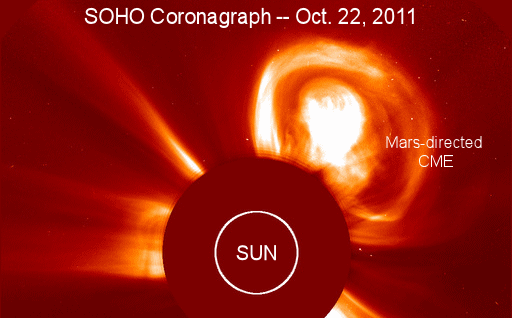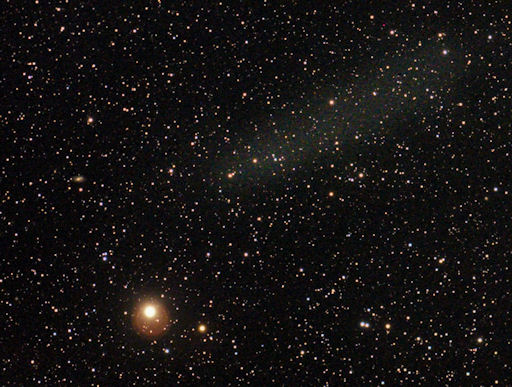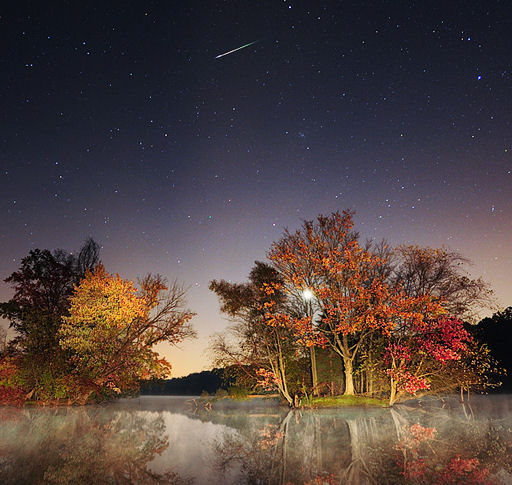SPACE WEATHER FORECAST FOR MARS: A bright CME blasted off the sun yesterday, Oct. 22nd, and it appears to be heading for Mars. Analysts at the Goddard Space Weather Lab expect the cloud to reach the Red Planet on Oct. 26th (forecast track). A brief discussion of what CMEs can do to Mars follows this SOHO image of the eruption:
Mars has a unique response to solar storms shaped by the planet's strange magnetic topology. Unlike Earth, which has a global magnetic field, Mars is patchily covered by dozens of "magnetic umbrellas"--remnants of an over-arching planetary field that decayed billions of years ago. When Mars gets hit by a CME, the resulting magnetic storms take place in the umbrellas. Circumstantial evidence collected by Mars Global Surveyor in the 1990s suggests that the tops of the umbrellas light up with bright ultraviolet auroras during such storms. Because the structures are distributed around the planet, these auroras can appear even at the equator.
Mars rovers and satellites should be alert for aurora equatoralis on Oct. 26th.
Bonus: Magnetic umbrellas are at the heart of one of Mars's greatest mysteries: What happened to the atmosphere? Billions of years ago, the air on Mars was thick enough to protect vast expanses of water on the planet’s surface. Now, however, the atmosphere is 100 times thinner than Earth's and the surface is bone dry. Some researchers believe that magnetic storms in the umbrellas could rip parcels of atmosphere away from Mars and propel air-filled magnetic bubbles into space. In this way, space weather could be directly responsible for the desiccation of the Red Planet.
COMET CORPSE: "Doomsday Comet" Elenin was briefly famous for inaccurate predictions that it might hit Earth. Instead it disintegrated as it approached the sun last month. (Doomsday canceled.) Over the weekend, Italian astronomer Rolando Ligustri spotted the comet's remains. It's the elongated cloud in this Oct. 22nd photo of the star field where Elenin would have appeared if it were still intact:
Another team of astronomers--Ernesto Guido, Giovanni Sostero and Nick Howes--spotted the cloud on the same night. At first they were skeptical. "The cloud was extremely faint and diffuse," says Guido. "We wondered if it might be scattered moonlight or some other transient artifact." But when the team looked again on Oct. 23, the cloud was still there. A two-night blink animation shows that the cloud is moving just as the original comet would have.
More information about this discovery and continued tracking of the "comet corpse" may be found at the Remanzacco Observatory Astronomy Blog.
WEEKEND METEOR SHOWER: The Orionid meteor shower peaked on Saturday, Oct. 22nd, when Earth passed through a stream of debris from Halley's comet. As many as 26 meteors per hour were visible from rural areas, according to the International Meteor Organization. Here is one of them streaking over the autumn leaves of Elverson, Pennsylvania:
"The sky was crystal clear and a moody fog was rising off the lake when I set up my camera at 1 o'clock Saturday morning," says photographer Jeff Berkes. "The Orionids we streaking bright and I counted a couple dozen during the night. I also saw 3 random meteors."
more photos: from Derek K of Ottawa, Ontario; from P-M Hedén of Vallentuna, Sweden; from Baroni of Choiseul, France; from Pete Lawrence of Selsey, West Sussex, UK; from Olivier Staiger of Crans-Montana in the Swiss Alps; from Leo Lam of Luogang, Guangzhou, China; from Jefferson Teng of Bandar Lampung, Indonesia; from Brian Emfinger of Ozark, Arkansas, USA; from Monika Landy-Gyebnar of Veszprem, Hungary; from Antti Pietikäinen of Muonio, Lapland, Finland; from Mark Staples of Waldo, Florida;




